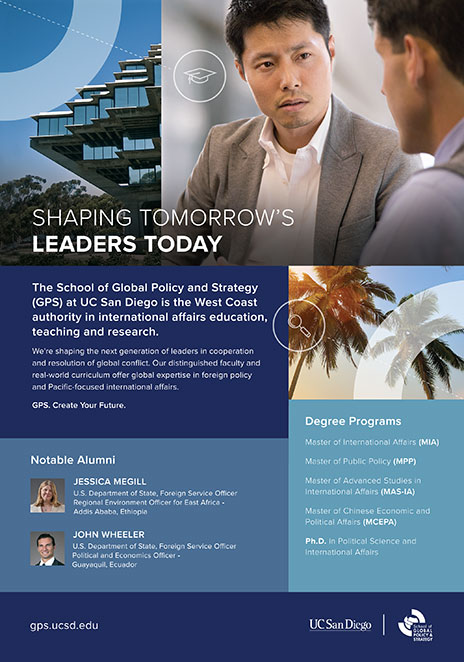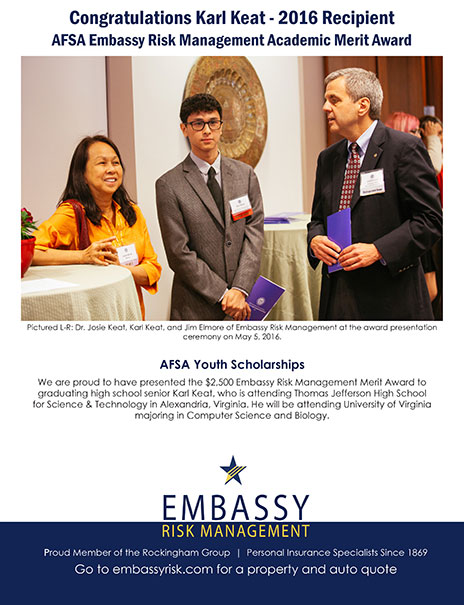Examining State’s Foreign Service Officer Hiring Today
Here's an inside look at the process of becoming a Foreign Service officer, considered the “gold standard” in professional recruitment.
BY GLENN J. GUIMOND
The traditional path to becoming a Foreign Service officer has evolved over the years as the State Department continues to seek a pool of candidates representing the diverse fabric of the United States, as well as ensure that the process more accurately and fairly chooses from among them. The State Department’s Board of Examiners assesses applicants to the Foreign Service. BEX assessors identify innovative thinkers and entrepreneurial leaders to be the next generation of Foreign Service officers and specialists, strengthening the department and the Foreign Service to meet the challenges of a complex global landscape.
BEX evaluates aspiring FSOs, specialists and limited non-career (LNC) candidates in 21 career tracks, including regional medical officers, consular fellows, information management specialists and others. To make use of the most appropriate and effective methods available, the BEX team works with department stakeholders and industrial psychologists to vet, validate and update test materials. This article outlines the basic steps to becoming a Foreign Service officer. The hiring process for specialists and LNC candidates is similar and spelled out on the State Department’s careers website, careers.state.gov.
Using a “total candidate” approach introduced in 2008, the current selection process improves the department’s ability to recruit and hire the best, compete more effectively with the private sector and be more efficient. Each step of the process is under continuous review to ensure efficacy and impact. The data for this evaluation comes, in part, from the candidates themselves in post-assessment surveys and social media platforms. Surveys of the new officers’ supervisors in the field provide additional data where “the rubber meets the road.” If deficiencies are identified, corrections are proposed, evaluated and—if found appropriate—implemented.
One very important thing remains the same: the process itself continues to be considered the “gold standard” in professional recruitment.
The various steps in the entry process are briefly described here. More detailed information is available at https://careers.state.gov/work/foreign-service/officer.
Starting the Process
Each candidate must carefully consider and choose a career track before applying. While all U.S. diplomats are expected to communicate U.S. foreign policy and advance U.S. interests worldwide, each track has a specific focus. Formerly known as “cones,” the five FSO generalist career tracks of the Foreign Service are consular, economic, management, political and public diplomacy.
The Foreign Service Officer Test
Candidates seeking to become Foreign Service officers, or generalists, next register for the Foreign Service Officer Test, which is offered three times a year—in February, June and October. Registration is open for the five-week period immediately prior to a specific testing window (this is a change from the previous, continuously open application period). When registering, the candidate submits an application and selects a seat at the same time. The candidate also must make a career track selection when registering.
Applications are valid only for that particular test and expire when the testing window closes. Once an application for a test window is submitted, it cannot be changed. Candidates may test only once in a 12-month period. Eligible candidates may submit new applications during each registration period, allowing them to update employment or other important information, and change their contemplated career track if they wish.
Like all elements of the entry process, the FSOT is under constant review.
The FSOT is a critical part of the FSO selection process, covering the job knowledge, English expression and biographic information necessary to work as a Foreign Service officer. The test is administered online and is comprised of a series of multiple-choice questions and an essay.
There are many resources available to help familiarize a candidate with the test at the Department of State’s website, https://careers.state.gov. Information provided there includes a Suggested Reading List and Course List; employee videos that communicate the range of work that Department of State professionals perform abroad and at home; a digital brochure, “Becoming a Foreign Service Officer,” which contains sample test questions; and links to download the DOSCareers mobile app to test themselves with “retired” questions from the FSOT.
There is even an online practice FSOT that simulates the actual testing experience and gives a prospective candidate an estimate of his or her likelihood of passing the real test. Those who took the practice FSOT and then took the actual FSOT had higher scores and higher passing rates than those who did not take the practice FSOT.
Like all elements of the entry process, the FSOT is under constant review. In response to dissatisfaction among Foreign Service managers over the quality of entry-level officers’ writing ability, BEX is seeking ways to better measure a candidate’s business writing skills. A 2,800-character word limit was applied to the essay portion of the February FSOT to encourage more concise text. BEX is also considering the addition of situational judgment questions, which will assess a candidate’s judgment and interpersonal skills.
Personal Narratives
If a candidate passes the FSOT, he or she then has three weeks to write six personal narratives (PNs), which answer questions describing the knowledge, skills and abilities a candidate would bring to the Foreign Service. These six promotion precepts (Leadership, Interpersonal Skills, Communication Skills, Management Skills, Intellectual Skills and Substantive Knowledge) are predictors of success in the Foreign Service.
The PNs offer candidates the opportunity to highlight not just what they have done, but how they did it and what they learned. Candidates are asked to provide examples from their experiences that demonstrate their abilities; identify learning experiences; and show how their learning experience will contribute to success in their chosen career track. Essentially, they must show they have the skills to be a successful FSO. Each career track is reviewed by a different panel made up of officers from that career track during the Qualifications Evaluation Panel.
The Qualifications Evaluation Panel
Implemented in 2007, the QEP uses a total-candidate approach to review candidates’ educational and work background, their responses to the PN questions, their self-evaluated language skill level and their FSOT scores.
Although the QEP is a total file review, the candidate has the most control over it through his or her responses in the PNs. These responses can be influential in determining a candidate’s standing in the chosen career track. This is their chance to tell their story to the Foreign Service assessors.
Nine years of data has shown that the better a candidate does on the QEP, the more likely he or she is going to pass the FSOA.
The QEP provides a service to both candidates and the department. Because it allows a look at the total candidate, the process has proven effective at indicating which candidates are likely to be successful in the oral assessment. Prior to the QEP, the department invited approximately the top 10 percent of scorers on the written exam to attend the Foreign Service Oral Assessment. Once the QEP was introduced, the invitee pool from the FSOT went from 10 percent to approximately 40 percent, thus providing a wider range of candidates for the QEP to review. While approximately the same number of candidates is invited to the FSOA now as before the QEP, about 49 percent of the candidates invited using the QEP pass compared to 21 percent pre-QEP.
Both the department and potential candidates have realized substantial savings. The department reduced expenditures in staff time; and candidates unlikely to pass the assessment were saved the transport and lodging expenses of a journey to Washington, D.C. In addition, the process provided a wider mix of applicants with a broader range of skills. Nine years of data has shown that the better a candidate does on the QEP, the more likely he or she is going to pass the FSOA. The total-candidate approach in the QEP has proven to be among the best practices for employee selection assessments.
Evidence also indicates that the QEP produces a qualitatively different and more diverse pool of candidates coming forward to the FSOA. Based on historical FSOA invitation rates, more than half of the candidates (56.2 percent) invited to the FSOA today would not have been invited based solely on the cognitive-based skills test, the FSOT. According to a 2013 survey of entry-level officer supervisors to determine if the introduction of the QEP was producing officers with the “right stuff,” today’s candidates bring more international work experience, education and experience living abroad to the department. As one respondent said, “It is not that today’s ELOs are better, but they are more consistently better.”
The Spigot—From QEP to FSOA
The QEP results in a rank-ordered list of FSO candidates by skill code or career track. In determining the number of invitations to be issued to the FSOA, the strength of the current register, by skill code, is evaluated. The number of invitations issued is based on the hiring foreseen for each skill code and the number of FSOs necessary to achieve that number. It is thus possible for more candidates of one skill code/career track to be invited to a particular FSOA than those from another skill code. It is also possible that a candidate could receive an invitation during a year in which hiring needs are anticipated to be high, but may not receive an invitation when hiring is expected to be low.
The Oral Assessment is conducted primarily in Washington, D.C. Resources permitting, BEX also offers it in San Francisco each year in January and May. The day-long Oral Assessment measures a candidate’s ability to demonstrate the 13 dimensions that are essential to the successful performance of an FSO’s work. It includes a group exercise, a structured interview and a case-management writing exercise. It is a job interview, not an educational exam.
The Oral Assessment exercises are based on a job analysis of the work of the Foreign Service. They reflect the skills, abilities and personal qualities deemed essential to the performance of that work. The exercises are not an adversarial process: candidates do not compete against other candidates, but instead are judged on their capacity to demonstrate the skills and abilities necessary to be an effective FSO.
The first update in a decade to the group exercise portion of the Oral Assessment was the addition of the “Ambassador Brief.” Feedback from candidates indicated concern that less demonstrative candidates were being drowned out by more vocal members of the group. An individualized interaction was suggested that would allow those candidates to exhibit their capabilities.
During the “Ambassador Brief,” candidates meet individually with the assessors, one of whom plays the role of an ambassador. The candidate briefs “the ambassador” on the outcome of the Group Exercise and explains the group’s rationale for its decision. Once initiated, assessors found that this exercise also provided an opportunity to evaluate how well the candidates followed, and were able to explain, the intricacies of the group discussion.
On the Careers portion of its website, the State Department provides resources that help familiarize candidates with the process. These resources include a “Foreign Service Officer Oral Assessment Information Guide”; a letter from the staff director of BEX, which contains a detailed explanation of the Oral Assessment and the 13 dimensions it measures; sample exercises; and a list of Frequently Asked Questions about the assessment.
The first update in a decade to the group exercise portion of the Oral Assessment was the addition of the “Ambassador Brief.”
Clearances
Candidates who pass the Oral Assessment will receive a conditional offer of employment and instructions about obtaining medical and security clearances to continue their candidacy. There is no guarantee of employment at this stage. Once the clearances are completed, the file goes to the Suitability Review Panel.
The Register
When candidates successfully pass the Foreign Service Officer Test; Qualifications Evaluation Panel; Oral Assessment; security and medical clearances; and a suitability review, they are placed on a hiring register. Candidates are rank-ordered on the register based on the specific career track they chose at the time they registered for the FSOT and their Oral Assessment score, plus any additional credit for language ability or veterans’ preference they may receive.
Veteran’s preference points or credit for demonstrated foreign language proficiency may raise a candidate’s standing on the register. Instructions on how to receive additional credit in these areas are provided on successful completion of the Oral Assessment.
Where We Stand
In recent years, up to 17,000 candidates have taken the Foreign Service Officer Test annually. A much smaller number advance to the QEP review, and approximately 1,000 per year are invited to the Oral Assessment. It should be kept in mind that FSO hiring targets are adjusted regularly. Many candidates with excellent qualifications who may have received an invitation to the Oral Assessment at a time of increased hiring will not receive one when the department’s hiring targets are lower or if there is an increase in the overall number of candidates. The process is highly competitive, and many candidates repeat the process more than once before succeeding.
The available data suggests that the current entry process results in a diverse, motivated and productive workforce. Minority representation in the Foreign Service has increased over the past 10 years, but is still not where the department would like it to be. In Fiscal Year 2003, Hispanic candidates represented 4.7 percent of FSOs hired, while in FY2015, 9.7 percent of those hired were Hispanic.
The percentage of African-American FSOs hired rose from 5.5 percent in FY2006 to 12.1 percent in FY2015. Although incoming Foreign Service classes are increasingly diverse and have nearly reached gender parity, except in a few specialist categories, it will take time before the workforce as a whole reflects these gains.
Our surveys of supervisors of new entry-level officers tell us that they possess strong work experience, technical and IT skills, and professionalism. Though this information is welcome, it by no means signals an end to the evolution of the entry process. FSOs themselves are expected to adapt to changing circumstances and to improve their performance over time. They do this through soliciting feedback from their peers and supervisors, as well as through critical self-assessment. The entry process for their profession should be no different.
The United States Department of State is fortunate to have so many outstanding candidates interested in joining the ranks of the Foreign Service. Those who have worked with the department’s entry-level professionals in recent years can attest to their outstanding skills and abilities. We will continue to evaluate the selection process to ensure that we are hiring the very best.
Read More...
- “Becoming a Foreign Service Officer/Becoming a Foreign Service Specialist” (Department of State)
- “On Diplomacy as a Profession” (AFSA interview with George Kennan, 1961)
- “Foreign Service Officer FAQ” (USAID)
- Featured Blogs:
- Inside a U.S. Embassy: Diplomacy at Work Edited by Shawn Dorman ─ Third Edition
- Career Diplomacy: Life and Work in the U.S. Foreign Service by Harry W. Kopp and Charles A. Gillespie ─ Second Edition





